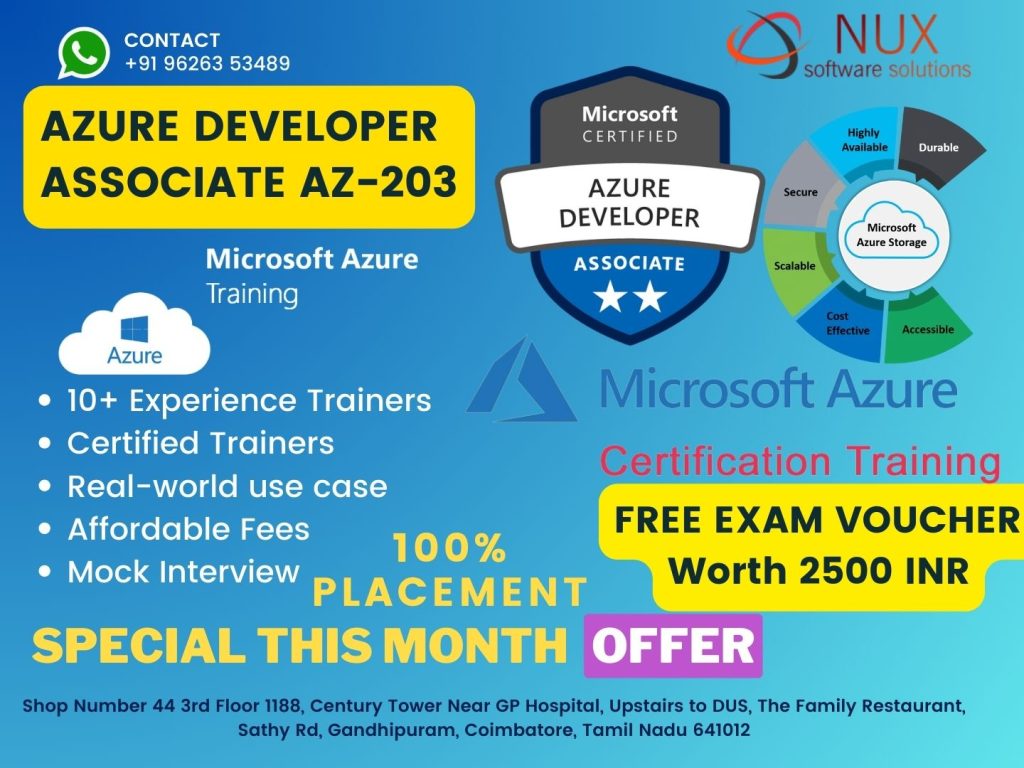Microsoft Certified: Azure IoT Developer Specialty Training and certification – AZ-220

AZ-220: Azure IoT Developer Specialty Training in Coimbatore
Course Overview
The AZ-220: Microsoft Certified Azure IoT Developer Specialty course is designed for professionals who want to build, configure, and maintain Internet of Things (IoT) solutions on Microsoft Azure. This certification validates your ability to implement cloud and edge components of an IoT solution using Azure services.
At Linux Training Center in Coimbatore, this hands-on training focuses on practical IoT development with real-time project exposure. From connecting devices to Azure IoT Hub to integrating AI and analytics, learners will gain end-to-end IoT development expertise.
Why Choose AZ-220?
As smart devices and industrial IoT systems continue to grow, certified IoT developers are in high demand. The AZ-220 certification establishes your credibility as a professional capable of developing and managing scalable, secure IoT applications on Azure.
This course is ideal for developers aiming to build solutions that interact with cloud-based platforms, making it a strong career path for those in automation, embedded systems, and smart technologies.
Who Should Enroll?
The course is perfect for IoT developers, embedded systems engineers, software developers, automation engineers, and cloud professionals who want to specialize in IoT applications using Azure.
Learners should have experience with Azure services, basic programming skills (C#, Python, or Node.js), and familiarity with hardware or embedded systems.
What You Will Learn
Create, configure, and manage Azure IoT Hub and device provisioning services
Implement device-to-cloud and cloud-to-device messaging using MQTT, AMQP, and HTTP
Secure IoT solutions using authentication, access control, and certificate management
Integrate IoT devices with Azure services such as Stream Analytics, Logic Apps, and Event Grid
Perform device management at scale, including updates and monitoring
Configure IoT Edge for local data processing and AI integration
Implement diagnostics, logging, and troubleshooting strategies for IoT solutions
This course includes real-time projects to simulate industrial automation, smart homes, and predictive maintenance use cases.
Course Highlights
Comprehensive coverage of all AZ-220 certification domains
Live hands-on training with simulated IoT environments
Instructor-led sessions with industry-expert guidance
Practice labs with Azure IoT Hub, Edge, and Device SDKs
Flexible batches: weekday and weekend formats available
Career Opportunities
After completing AZ-220, you can pursue roles such as IoT Developer, Azure IoT Engineer, Embedded Solutions Architect, or Cloud IoT Consultant. This certification is highly valuable in industries like manufacturing, energy, smart cities, healthcare, and logistics.
Why Linux Training Center?
At Linux Training Center in Coimbatore, we offer skill-based Azure training that goes beyond certification. Our AZ-220 course blends conceptual clarity with real-world applications to prepare learners for impactful roles in the rapidly evolving IoT domain.
Azure IoT Developer Specialty - AZ-220 Syllabus
Modules
Set up the Azure IoT Hub Solution Infrastructure (10-15%)
Create and configure an IoT Hub
- Create an IoT Hub
- Register a device
- Configure a device twin
- Configure IoT Hub tier and scaling
Build device messaging and communication
- Build messaging solutions by using SDKs (device and service)
- Implement device-to-cloud communication
- Implement cloud-to-device communication
- Configure file upload for devices
- Optimize message size and scaling for IoT Hub
- Connect to IoT Hub by using Transport Layer Security (TLS) server certificates
Configure physical IoT devices
- Recommend an appropriate protocol or gateway based on device specifications
- Configure device networking, topology, and connectivity
- Add IoT Plug and Play capabilities to a device in a model-driven solution
Provision and Manage Devices (15-20%)
Set up the device provisioning Service
- Create a device provisioning service
- Create a new enrollment in the device provisioning service
- Link an IoT Hub to the device provisioning service
Manage the device lifecycle
- Provision a device by using the device provisioning service
- Deprovision an auto-enrollment
- Decommission (disenroll) a device
Manage IoT devices by using IoT Hub
- Manage devices list in the IoT Hub device registry
- Modify device twin tags and propertiesa
- Specify a set of devices to manage by using IoT Hub Automatic Device Management
- Implement and manage configuration on a set of devices by using IoT Hub Automatic Device Management
- Control access to device functionality by using module identities and module twins
Manage IoT devices by using Azure IoT Central
- Create and manage device templates by using Azure IoT Central and Digital Twins Definition Language (DTDL)
- Configure rules, actions, and commands in Azure IoT Central
- Add, enroll, and manage devices by using Azure IoT Central
- Manage Azure IoT Central applications, including security, tenants, customization, and visualizations
- Manage data integration, including data ingress, data export, and data transformation
- Configure and manage Azure IoT Central jobs
- Manage Azure IoT Central by using APIs
Implement IoT Edge (15-20%)
Set up an IoT Edge device
- Create a device identity in IoT Hub
- Set up an IoT device for IoT Edge
- Install container runtime on IoT devices
- Configure container startup options to interact with the host system
- Update IoT Edge runtime
- Provision IoT Edge devices by using the device provisioning service Deploy an IoT Edge device
- Create and implement a deployment manifest
- Create a deployment for a single IoT Edge device
- Create a deployment to target multiple devices
- Create a continuous deployment by using Azure DevOps
Develop IoT Edge modules/h4>
- Create and customize an IoT Edge module
- Deploy a custom IoT Edge module to an IoT Edge device
- Publish an IoT Edge module to Azure Container Registry
- Define module configuration
- Configure IoT Edge module routing
- Configure an environment for IoT Edge development
Configure an IoT Edge device
- Select an appropriate gateway pattern
- Deploy an IoT gateway by using IoT Hub and IoT Edge
- Configure IoT Edge certificates
- Implement and configure offline support (including local storage)
- Create a layered hierarchy of IoT Edge devices
- Interact with the IoT Edge security manager
Implement Business Integration (5-10%)
Integrate with upstream and downstream systems
- Set up input and output connections to support native Azure services and to enable third-party services
- Set up IoT Hub routing to support downstream Azure resources
Develop an IoT solution that uses Azure Digital Twins
- Create models and digital twins
- Map IoT device data to digital twin models and relationships
- Ingest IoT device messages, and translate messages to digital twins
- Configure routes and endpoints to trigger business logic and data processing
- Manage and query the Azure Digital Twins graph
- Update properties on Azure Digital Twins entities in the graph
- Monitor and troubleshoot Azure Digital Twins
Process and manage data (15-20%)
Configure message routing in Azure IoT Hub
- Implement message enrichment in IoT Hub
- Implement routing of IoT device telemetry to endpoints
- Implement routing of IoT Hub non-telemetry events to endpoints
- Define and test routing queries
- Configure IoT Hub as an Azure Event Grid source
- Reconfigure the default Azure Event Hubs endpoint when there are multiple endpoints
Configure stream processing of IoT data
- Create Azure Stream Analytics for data, and stream processing by using the Azure portal
- Process and filter IoT data by using Azure Functions
- Write user-defined functions and aggregations in Stream Analytics
- Consume Azure Machine Learning functions in Stream Analytics
- Configure Stream Analytics outputs
Create Azure Stream Analytics queries
- Write a Stream Analytics query that runs in IoT Edge
- Write a Stream Analytics query that runs in the cloud
Process real-time data by using Azure Time Series Insights
- Create a Time Series Insights environment
- Connect the IoT Hub and the Time Series Insights environment
- Create a reference data set for a Time Series Insights environment by using the Azure portal
- Implement Time Series model hierarchies, types, and instance fields
- Consume data by using Time Series Expression syntax
Monitor, troubleshoot, and optimize IoT solutions (5-10%)
Configure health monitoring
- Configure rules and alerts based on IoT Hub metrics
- Set up diagnostics logs for IoT Hub
- Apply Azure Policy definitions for IoT Hub
- Gather IoT Edge metrics
- Retrieve diagnostic logs from IoT Edge
Troubleshoot device communication
- Verify that device telemetry is received by IoT Hub
- Validate device twin properties, tags, and direct methods
- Troubleshoot device disconnects and connects
- Troubleshoot IoT Edge modules and devices
- Troubleshoot message loss
- Evaluate and test IoT Hub failover
Implement security (5-10%)
Implement security for IoT devices and services
- Implement device and gateway security, including shared access keys, key rotation, managed identities, Hardware Security Modules (HSMs), and Trusted Platform Modules (TPMs)
- Implement secure connections, including access control, authentication, shared access policies, and TLS
- Implement secure networking, including IP filtering and private endpoints
Implement Microsoft Defender for IoT
- Configure a Defender for IoT agent-based solution
- Install and configure Defender-IoT-micro-agents (security agents)
- Configure built-in and custom alerts for IoT Hub
To ensure success in the Microsoft Azure IoT Developer certification exam, we recommend authorized training courses, practice tests, and hands-on experience to prepare for Microsoft Azure IoT Developer (AZ-220) exam.



